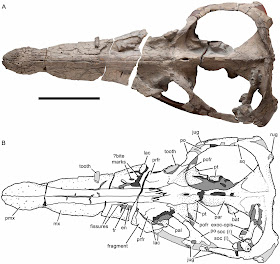The Pliosaurs were Mesozoic marine reptiles that arose in the Late Triassic or Early Jurassic and persisted till the Late Cretaceous. They were related to modern lizards and snakes, but were fully aquatic, the largest species reaching 15 m in length. All species seem to have been strict carnivores, and at least one species gave birth to live young. Plesiosaurs are thought to have been fully aquatic from their first appearance; they are thought to have evolved from Nothosaurs, a group of semi-aquatic marine Reptiles. The term Sauropterygians is used to include the Nothosaurs and the Pliosuars, plus the Pachypleurosaurs; Lizard-like aquatic Reptiles. The Sauropterygians are considered to be the sister group of the Squamates - Snakes and Lizards.
In a paper published in the journal PLoS One on 31 May 2013, a team of scientists led by Roger Benson of the Department of Earth Sciences of the University of Oxford describe a new species of Pliosaur from the Late Jurassic of the Dorset coast in southern England.
The new species is named Pliosaurus kevani, after Kevan Sheehan of Osmington Mills in Dorset, who collected the specimen in pieces from fallen blocks on the foreshore at Osmington over a period of eight years. The assembled specimen is a nearly complete skull 1995 mm in length and 730 mm across, the cranium comprising 57% of the skull length, and the snout the remainder.
Cranium of Pliosaurus kevani in dorsal view, photograph (A) and line drawing (B). Dark grey tone represents broken bone surface, mid grey represents matrix, and light grey represents tooth or artificial restoration. Abbreviations: bat, basal tuber; en, external naris; exoc-opis, exoccipital opisthotic; fr, frontal; jug, jugal; lac, ‘lacrimal’; mx, maxilla; pal, palatine; par parietal; pmx, premaxilla; po, postorbital; pofr, postfrontal; prfr, prefrontal; pt, pterygoid; rug, rugose eminence; soc (l), left portion of supraoccipital; soc (r), right portion of supraoccipital; sq, squamosal.

Cranium of Pliosaurus kevani in ventral view. In line drawing (B) dark grey tone represents broken bone
Scale bar equals 500 mm.
Benson et al. (2013).
Cranium of Pliosaurus kevani in ventral view. In line drawing (B) dark grey tone represents broken bone
surface, mid grey represents matrix, and light grey represents tooth or artificial restoration. Abbreviations: bat, basal tuber; cfps, cultriform process of
the parasphenoid; ecto, ectopterygoid; exoc-opis, exoccipital-opisthotic; in, internal naris; jug, jugal; mx, maxilla; mx19, 19th maxillary alveolus; occ,
occipital condyle; pal, palatine; pal-pt, palatine-pterygoid contact; palf, palatal fenestra; par, parietal; pmx, premaxilla; ps, parasphenoid; pt, pterygoid;
soc (l), left portion of supraoccipital; sof, suborbital fenestra; sq, squamosal; vom, vomer; vom-pt, vomer pterygoid contact. Scale bar equals 500 mm.
Benson et al. (2013).
Pliosaurus kevani is a Late Jurassic Pliosaur dated to the Rasenia cymodoce biozone of the Lower Kimmeridgian, making it between 155.7 and 150.8 million years old. It is large for a Pliosaur of this age, though fragmentary material from specimens thought to be of similar size has been found previously. Pliosaurs appear to have grown in size steadily from the appearance of the group until the Early Cretaceous, with later Cretaceous members of the group growing slightly smaller again. The largest Early Cretaceous Pliosaurs exceeded 2360 mm in skull length, with some fragmentary material from animals estimated to be far larger.
See also New species of Placodont from the Middle Triassic of the Netherlands, A Plesiosaur from the Early Jurassic of Portugal, An Early Jurassic Pliosaur from Normandy, A Pregnant Plesiosaur and The Weymouth Pliosaur.
Follow Sciency Thoughts on Facebook.
Reconstruction of the skull of Pliosaurus kevani in right lateral (A), dorsal (B), and ventral (C) views. Abbreviations: ang, angular; art, articular; den, dentary; en, external naris; exoc-opis, exoccipital-opisthotic; in, internal naris; jug, jugal; fr, frontal; lac, ‘lacrimal’; mx, maxilla; occ, occipital condyle; pal, palatine; palp, palpebral; par, parietal; pifor, pineal foramen; pmx, premaxilla; po, postorbital; pofr, postfrontal; prfr, prefrontal; proo, prootic; ps, parasphenoid; pt, pterygoid; sa, surangular; soc, supraoccipital; sq, squamosal; vom, vomer. Total skull length is approximately 2 meters. Benson et al. (2013).
The location where Pliosaurus kevani was recovered. Scale bar is 500 m. Benson et al. (2013).
See also New species of Placodont from the Middle Triassic of the Netherlands, A Plesiosaur from the Early Jurassic of Portugal, An Early Jurassic Pliosaur from Normandy, A Pregnant Plesiosaur and The Weymouth Pliosaur.
Follow Sciency Thoughts on Facebook.



